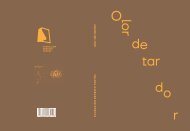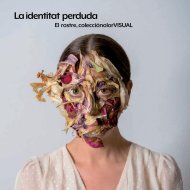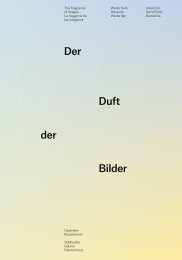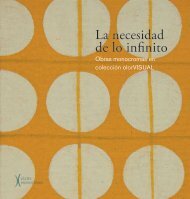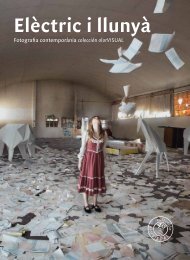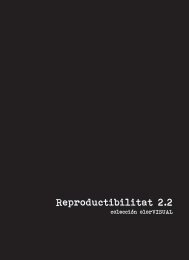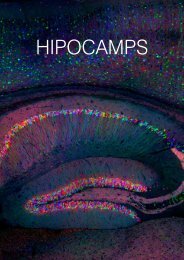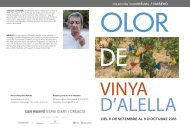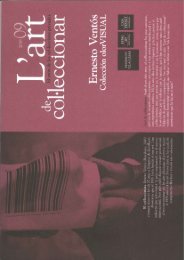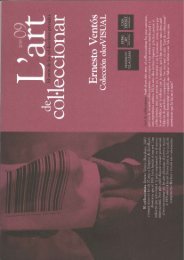Create successful ePaper yourself
Turn your PDF publications into a flip-book with our unique Google optimized e-Paper software.
taste flavours, hear sounds and feel when we touch something, when one of<br />
these senses is severely underdeveloped or absent, another one often develops to<br />
an unusual degree. But is it possible to experience flavours when we hear words?<br />
Can we see colours when we hear a sound? Of course we can. This is what is<br />
known as synaesthesia, which is as closely tied to art as it is to life itself; in fact, it<br />
is said that newborns experience the different senses mixed together.<br />
The sensation of art, just like the sensation of synaesthetic perceptions,<br />
is often automatic or involuntary. Sometimes, as with synaesthesia, this first<br />
impression becomes a phenomenon that remains stable over time. Other times,<br />
it becomes more a recollection and vanishes. However, just like all information,<br />
this sensation is stored as a memory, and over time it becomes increasingly<br />
inaccessible, turning into what we call the curve of forgetting. Also, into the<br />
context of our lives. Hence this exhibition is curated in this way, even though<br />
it more resembles the literary resource of synaesthesia than synaesthesia<br />
itself. Ultimately, the goal is to emphasise each work’s condition to create an<br />
ambiance, an atmosphere which is capable of enriching the description of this<br />
idiosyncratic, unique collection made up of the visual scent of Ernesto Ventós.<br />
This exhibition, which includes some of the fascinating works from the<br />
olorVISUAL collection, attempts to activate the senses, something like penetrating<br />
a sensorial abyss related to our history, to life. As viewers, we will have the sense of<br />
walking and surrendering to the unknown, similar to walking through a forest, like<br />
someone who is chasing a scent. Thus, different temperatures are generated, taking<br />
advantage of the memory and nature of the space. Some will operate separately,<br />
individually, while others seek joint meanings, getting a new lease on life when they<br />
are visually conjoined. The space is planned from many different vantage points.<br />
Not a few authors focus their experiences through synaesthesia: painters like<br />
Kandinsky, poets like Arthur Rimbaud, composers like Alexander Scriabin and<br />
Olivier Messiaen and writers like Vladimir Nabokov are just a few examples.<br />
Synaesthesia is a mix of auditory, visual, gustative, olfactory and tactile sensations,<br />
something like a maximum expansion of feelings, associations that help us to<br />
memorise abstract concepts by linking them to sensorial realities; in short, associations<br />
that help us to understand the metaphorical universe of contemporary art.<br />
Together, the works in the olorVISUAL collection expand the meanings of<br />
each individual work with their olfactory traits. It is not so different from when<br />
Joseph Kosuth planned his work One and Three Chairs in the 1960s with the goal of<br />
offering the viewer a kind of analytical interpretation of three ways of channelling<br />
the meaning of the same object. The proposal is closer to synaesthesia than to the<br />
world of hallucinations because it is not a false perception. Nothing in the environs<br />
triggers a hallucination—unless one is under the effect of substances like LSD,<br />
for example—but in synaesthesia there is an external stimulus that induces the<br />
synaesthetic sensation. Hope as green or that love is red are colour notions that waver<br />
if we think about Fauvism. Only by putting ourselves in the place of the synaesthetic<br />
association can we understand the real existence of a red room or blue apples. Only a<br />
synaesthete can see the word ‘sky’ as orange, even if it is written in black ink.<br />
The attitude of the perfumer, a trade in which Ernesto Ventós worked<br />
through family tradition and vocation, envelopes us in another time. It is similar<br />
to what Michael Hardt once described regarding time in prison, a time that<br />
stretches and collapses in a kind of optical illusion. It is a predestined time where<br />
nothing is unpredictable. Hence prisoners try in vain to grasp onto this volatile<br />
and ephemeral time by giving it some expression, even if just symbolically,<br />
such as by making scratches on the wall to mark its passing. In the works of the<br />
olorVISUAL collection, the opposite happens: time stretches out as a defence<br />
mechanism against a world of events that happen too quickly.<br />
132




